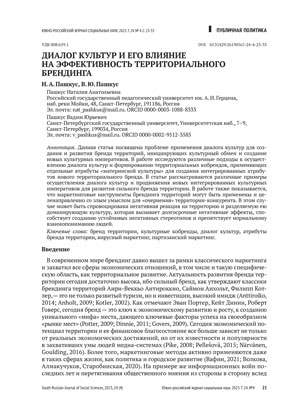Abstract
This paper focuses on using the dialog of cultures to create and develop the brand of territories that promote cultural exchange and establish new cultural imperatives. The article explores different methods for implementing the dialog of cultures and creating territorial co-brands by utilizing unique characteristics of the ‘mother culture’ to form integrated attributes of a new territorial brand. The article examines different cases of implementing the dialogue of cultures and promoting new integrated cultural imperatives to develop a strong territorial brand. The paper shows that territorial branding tools can be used maliciously to defame a competitor’s territory. In this case, a negative reaction to the territory and its dominant culture can be provoked, leading to long-term negative effects. This can contribute to the creation of stable negative stereotypes and hinder mutual understanding.
Keywords
References
Будко Д.А., Волкова А.В., Кулакова Т.А. (2022). Цифровой вигилантизм: экономический ракурс. Проблемы современной экономики, 1, 83–87.
Вафин, А.М. (2021). Негатив в политике: 10 технологий «черного» PR в России и зарубежных странах. Вопросы политологии, 1(65), 107–114.
Волкова, А.В., Алмакучуков К.М., Старобинская Н.М. (2020). Новые технологии городского развития и управление арт-рынком: опыт Санкт-Петербурга. Проблемы современной экономики, 1, 173–176.
Foroudi, P., Gupta, S., Kitchen, Ph. J., Foroudi, M.M. (2016). A Framework of Place Branding, Place Image, and Placereputation: Antecedents and Moderators. Qualitative Market Research: An International Journal, 19(2), 241–264.
Anttiroiko, A.-V. (2014). The Political Economy of City Branding. London: Routledge.
Anholt, S. (2009). Places: Identity, Image and Reputation. London: Palgrave Macmillan.
Anholt, S. (2007). Competitive Identity: The New Brand Management for Nations, Cities and Regions. London: Palgrave Macmillan.
Avraham, E., Ketter, E. (2012). Media Strategies for Marketing Places in Crisis. London: Routledge.
Bowen, J., Whalen, E. (2017). Trends That are Changing Travel and Tourism. Worldwide Hospitality and Tourism Themes, 9 (6), 592–602.
Braun, E., Kavaratzis, M., Zenker, S. (2013). My City — My Brand: the Role of Residents in Place Branding. Journal of Place Management and Development, 6(1), 18–28.
Dinnie, K. (2011). City Branding: Theory and Cases. London: Palgrave Macmillan.
Florek, M., Kavaratzis, M. (2014). From Brand Equity to Place Brand Equity and from There to the Place Brand. Place Branding and Public Diplomacy, 10, 103–107.
Govers, R. (2009). Place Branding: Glocal, Virtual and Physical Identities, Constructed, Imagined and Experienced. London: Palgrave Macmillan.
Kavaratzis, M., Hatch, M.J. (2013). The Dynamics of Place Branding: an Identity-Based Approach to Place Branding Theory. Marketing Theory, 13 (1), 69–86.
Kotler, P., Gertner, D. (2002). Country as Brand, Product, and Beyond: a Place Marketing and Brand Management Perspective. Journal of Brand Management, 9 (4–5), 249–261.
Medway, D., Warnaby, G. (2008). Alternative Perspectives on Marketing and the Place Brand. European Journal of Marketing, 42 (5/6), 641–653.
Närvänen, E., Goulding, Ch. (2016). Sociocultural Brand Revitalization: The Role of Consumer Collectives in Bringing Brands Back to Life. European Journal of Marketing, 50 (7/8), 1521–1546.
Pellešová, P. (2015). Tourism and Multiplication Effects in the Region. In Business Information Management Assoc., (pp. 515–520).
Pike, St. (2008). Destination Marketing: An Integrated Marketing Communication Approach. Oxford: Butterworth-Heinemann.
Potter, E.H. (2009). Branding Canada. Projecting Canada’s Soft Power Through Public Diplomacy. Montreal: McGill-Queen`s Univ. Press.
Richards, G. (2018). Cultural Tourism: A Review of Recent Research and Trends. Journal of Hospitality and Tourism Management, 36, 12–21.
Schroeder, J.E. (2014). Brands: Interdisciplinary Perspectives. London: Routledge.
Massey, G., Kliestikova, J., Kovacova, M., Dengov, V.V. (2018). The Perceived Accuracy of Fake News: Mechanisms Facilitating the Spread of Alternative Truths, the Crisis of Informational Objectivity, and the Decline of Trust in Journalistic Narratives. Geopolitics, History and International Relations, 10 (2), 37–43.
Zhang, H., Wu, Y., Buhalis, D. (2018). A Model of Perceived Image, Memorable Tourism Experiences and Revisit Intention. Journal of Destination Marketing & Management, 8, 326–336.


